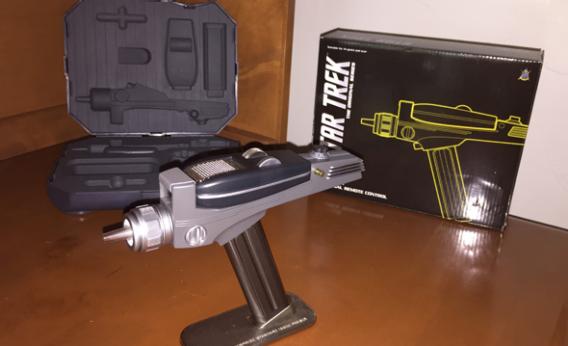Create a free profile to get unlimited access to exclusive videos, sweepstakes, and more!
Set Phasers to Buy

I don’t generally review products on the blog, for a lot of reasons. Mostly it’s because I don’t want to waste my time or yours with negative reviews of stuff that made me cranky somehow (like a sky mapping app I tried recently that refused to let me use my current location, instead insisting I was in Australia)—especially when I have a sneaky suspicion the problem is my fault, but I can’t trace it.
On the other hand, sometimes truly cool stuff comes along, and it’s a pleasure to write something about it. When that something comes from ThinkGeek, well, that’s even easier.
And if it’s a Star Trek prop? C’mon.
I am a bona fide Star Trek dork (I present Evidence A and Evidence B), but I don’t have a lot of swag to prove it. So when I saw the replica Hand Phaser prop at the ThinkGeek booth at San Diego Comic-Con, I knew I had to have it.
Two things. First, tl;dr: This prop is very well made, and the sounds it makes are great. It’s also a universal remote control, but a bit clunky for use that way (though fun). If you buy it, it’ll be because it’s just really cool, and not because you need a new remote. It’ll set you back $149.99.
Second, the good folks at ThinkGeek gave me this prop to review it. However, I cannot lie to you: I like TG’s stuff, and the phaser really is all that. If I didn’t like it, I’d say so.
I like it.
The phaser comes in a hard plastic shell protective carrying case, with molded foam interior for storing the parts. The case is labeled “U.S.S. Enterprise NCC-1701 Standard Issue Phaser,” in case you forgot what ship you’re pretending to be on.
You have to do a tiny bit of assembly, basically just attaching the handle (a screwdriver is included). For those of you who sadly are not Trekkies, the small weapon is called a Type I phaser, and that can snap into the larger handled Type II phaser pistol. In this prop, the Type I phaser has the rechargeable battery in it (a micro-USB cable is included, though any will work). The whole assembly comes with a metal display stand that grips it using rare-Earth magnets, which is pretty slick.
The phaser has a wide array of modes and sounds. The instructions were unusually lucid for such a thing; the closest I’ve ever come to desiring murder is reading instructions for assembling or using some device or another. In this case, the directions are quite clear, with only a slight bump due to unfamiliar parts (you’ll need to know the difference between the Mode Selector Button, the Phaser II dial, and so on, but the diagram included in the instructions is very helpful).
The phaser is lovingly crafted metal and plastic, with high attention to detail. It feels good in your hand, like a well-designed tool should. It’s not a lightweight piece of junk; it feels solid.
The phaser sounds are great; it makes nine different sounds replicated loudly and clearly. Trying to be a smug know-it-all jerk at Comic-Con, I asked the ThinkGeek rep who was showing it to me if it would do a “forced chamber explosion,” a setting in the show that overloads the energy source of the phaser, causing it to explode.
He smiled, turned the dial to 9, and hit the button. To my delight, the familiar whining sound started, building up. He then unscrewed a small plastic knob on the side of the phaser, and I could see the “dilithium crystal” going through a series of color changes, the sound building, until the weapon “exploded” (well, made a “kaboom” sound). Pretty much at that point I was shouting “shut up and take my money!”
Here's a quick video I made showing you the features:
As a prop/toy/collectible, it’s seriously top notch. But wait! There’s more!
It’s also a universal remote control. Sort of.
The phaser can be programmed to control a TV set (or cable box). These are all done using hand gestures; you can pump the phaser forward, backward, right, left, up, down, or tilt it left and right for a total of eight gesture commands (plus just using the trigger, giving you nine options). There are four color-coded “memory banks” for storing gestures, so you can have up to 36 such remote control commands.
It took me a few minutes to understand how to program it, but once I got it the commands stored easily. The thing is, there’s no way to check which gesture (or which memory bank it’s in) does which remote command. Was the tilt left changing the channel, or was that trigger/pump forward? Without that sort of guide, the phaser’s use as a remote is limited, unless you have a very good memory (or want to have a written list mapping gestures to commands).
But seriously. I don’t think people will buy this phaser only because they need a remote. That’s just silly fun added to what’s already a pretty amazing prop. And I’ll admit: It’s fun to set it to turn on and off the TV by firing at it. That will prove amazingly satisfying when commercials come on.
It’s not cheap, but quality comes at a price. If you’re a die-hard Trek fan or you know one, and you’ve got the cash, then you want this.


























